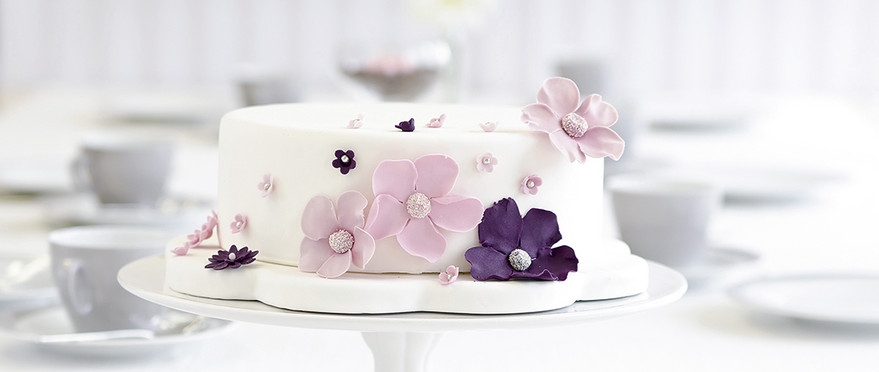Rolled fondant and pastillage
Fondant is a soft, supple mass that is very versatile and easy to colourise.
Rolled out, it is used to cover cakes and gateaux or to work them into ornaments, flowers or frills, emboss them with patterns or cut them into beautiful shapes. Fondant is also known as sugar paste, covering paste or ready to roll icing.
What kind of surfaces can be covered with fondant?
A suitable base for fondant is butter cream, as the fondant will stick very well to it. Dry cakes can also be covered with fondant, if they are previously coated with a little butter cream or reboiled jam. Whipped cream, however, can not be covered with fondant, as the high water content would soften or even dissolve the fondant. If you want to cover a cream pie with fondant, you will always have to add a separating layer in-between.
How do I process rolled fondant?
Before working with it, fondant must be kneaded well and then rolled out. A good helper is so-called baker’s starch, because it is very fine and does not make the fondant sweeter than it already is, which is why we wouldn’t recommend powdered sugar. After rolling the fondant, it can be used to cover cakes or to make decorative ornaments with it using our special cutters.
A tip from our confectioner: Should the fondant be too soft for processing, it can help to knead approximately 1 tsp of food glue (e.g. STÄDTER CMC Sugarcel) into 250g of fondant. If the fondant is too hard, on the other hand, you might knead in a small amount of coconut oil or glycerine.
Can I colour fondant?
Fondant is very easy to colourise. Pasty food colours are especially well suited, because their colour content is very high while having a low water content. In comparison with marzipan, rolled fondant has the advantage of being pure white, which makes colouring in light colours much easier.
What can I do if my fondant is too firm and dry?
Rub your hands with a small amount of vegetable fat and gently knead the fondant. This distributes the vegetable fat evenly and your fondant will become more supple.
What can I do if my fondant is crumbly?
Apply hot water to the crumbly spots for a short moment and then knead them thoroughly. Repeat until you have reached an even consistency. In general, you should make sure to always store fondant in airtight packaging.
What do I need to know about storage?
Rolled fondant must be stored in a cool and dry place, but not in the refrigerator. Once opened, our fondant can be stored for up to 3 months in an airtight container, and even longer if you freeze it. If you want to store coated cakes in the refrigerator, you should put a plate of salt next to it to remove moisture from the refrigerator.
What do I need to know if I am allergic?
Fondant is gluten-free and does not contain almonds and nuts, so that people allergic to those ingredients can use fondant without qualms.
Tipp: Making pastillage with fondant
Pastillage is ideal for modelling flowers, figures and fine decorations. Using our rolled fondant and CMC Sugarcel (cellulose powder), you can easily create pastillage by yourself.





